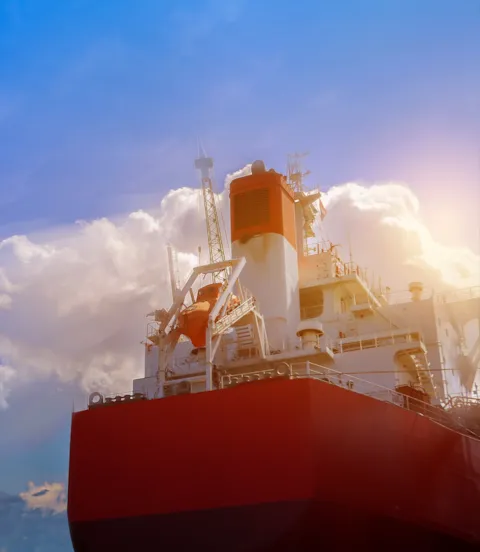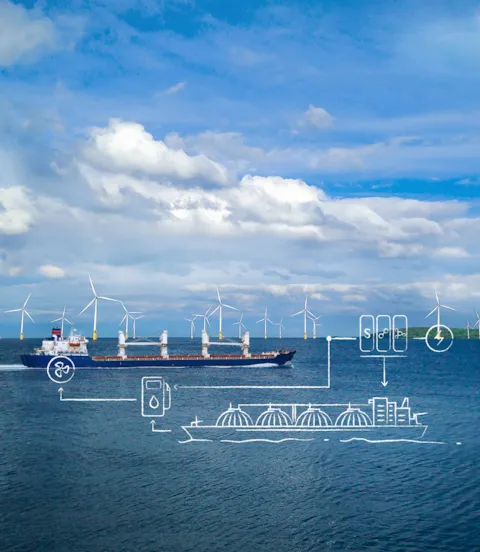Putting yourself ahead of the pack with the carbon-robust ship
The carbon-robust model can assist ship owners in choosing future-proof vessels, ensuring long-term competitiveness and profitability as the maritime industry decarbonizes.
“We are in an energy transition,” says Øyvind Endresen, Environmental Consultant, at DNV GL’s Environment Advisory section. “Global regulations on emissions to air as well as the rapid rise and faster cycling of new fuels and technologies are poised to change the fleet of the future.”
These changes are exposing the shipping industry to more risk than it has seen in many years and at a more fundamental level. When a vessel was planned 50 or even 20 years ago, the choices were much simpler. Size and cargo types varied, as did market drivers, but there was essentially only one choice of fuel and propulsion system. Today, the question of the propulsion technology, the fuel to be used, and even the crewing, is much more complex.
Overcome uncertainties of decarbonization
“There are many uncertainties to consider when investing in new tonnage,” says Magnus Eide, Principal Consultant, at DNV GL’s Environment Advisory section. “But without a doubt, today’s ship owners face more change in the near future than at any time in recent memory. We cannot assume that the regulatory and technology landscape will remain stationary, and we need to examine the questions of what is next, how can we plan for the future, and what are the factors we need to take into account.”
The carbon-robust model was launched in 2017 by DNV GL as part of the Maritime Forecast to 2050 to help manage this uncertainty and navigate towards this new future. The model can be used when developing ships that can withstand regulatory, fuel, technological and market shifts. A carbon-robust ship is one that is competitive and thrives in any decarbonization scenario.

Evaluating fuel and technology options
The core of the carbon-robust model lies in evaluating different fuel and technology options by comparing the break-even costs (the minimum rate that a ship must secure to cover all costs) of a design to that of the competing fleet of ships under different scenarios. The break-even cost is the minimum rate that a ship must secure to cover all its costs.
“A scenario-based model lets us explore design options and stress-test them for ship or fleet competitiveness under a range of possible regulatory, technology and energy price futures,” says Endresen. “This helps to deal with the uncertainty of how regulations and technologies will evolve in the next decades. The model also lets us see where the competitive advantages lie, not just at launch but over a vessel’s lifespan.”

How does the carbon-robust model work?
To begin, a set of fuel and technology choices for a vessel to be built in 2020 needs to be selected. The model then estimates the CO2 emission levels and total annual costs. Fuel prices and CO2 tax levels can be changed from pre-set levels.
The results are indicated for the period between 2020 and 2050. The performance of the vessel is compared with the performance of the rest of the fleet. The break-even distribution for the fleet is utilized in the comparison.

Who is my competition?
The competing fleet consists of ships currently operating and of ships being added to the fleet in the years to come. As time progresses, the future fleet is constructed by scrapping ships and building new ones. The number of ships to be scrapped and built is governed by the scenario description. Towards 2040 and 2050, the fleet composition is dominated by vessels built after 2020. Each new vessel is allocated an energy efficiency level, an exhaust treatment measure if required (e.g. scrubber), and a fuel and engine type.
“The model allows for the inclusion of a range of different fuel choices that can be applied to any ship type and the competing fleet, everything from HFO and scrubber to LNG,” says Endresen. “You can then add, change or remove different energy efficiency measures to your design – adding PIDs (propulsion improving devices), for example, or improved digital services like weather routing or planning optimization. These elements are reflected in the costs of your vessel and its fuel consumption over time. We can work with customers to build a model for their own plans, including the vessel type, and for their operational profile, and include their own projections on the future of the market. With all of this, we can then examine the most promising options for their individual case.”

Case study for different decarbonization scenarios
To demonstrate the model’s application, Eide and the Maritime Forecast team drew up a case study on the performance of three different VLCC designs, built in 2020. Each uses different energy efficiency technologies, of which one design is fuelled by LNG. Performance is tracked over 20 years, under two different decarbonization scenarios: Dull Blue to indicate business as usual and Bright Green to indicate a more driven approach to carbon reduction, including a carbon levy of USD 50 per tonne of CO2 from 2030.
The results of the case study suggest that any way you cut the numbers, improving energy efficiency is essential. “There are significant differences in competitiveness, but the results indicate that the energy-efficient ship (design C) is the most robust choice in terms of break-even competitiveness, with the best balance over both the short and long term. However, we also see that vessels which continue to run on conventional fuels with scrubbers are potentially very vulnerable to changes in GHG regulations, which could expose owners to significant market and price risks in 2030 and 2040,” says Eide.

Reduction of GHG emissions as an innovation driver
Eide is quick to note that the case study covers only a very limited set of technologies and fuels, and to come to firmer conclusions would require additional scenarios and designs. The indications of the Maritime Forecast and the carbon-robust model are clear though, says Endresen: “The reduction of GHG emissions will drive innovation in shipping. In addition to energy-efficiency measures, we will most likely see the widespread adoption of low or zero-carbon fuels. We believe the carbon-robust model could be a valuable supplement to ship owners in their newbuilding process and give investors and financiers an indication of the competitiveness over the financing period. By applying a structured, knowledge-based approach, supported by modelling tools, stakeholders put themselves ahead of the pack and remain competitive moving forward.”
